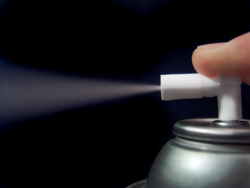Aerosol Sprays ----- 1926 Norway by Erik Rotheim.
Erik Rotheim was a Norwegian Engineer.
He was born in Kristiania, Norway and graduated from Switzerland in Engineering.
He patented his Aerosol can and valve on November 23rd, 1927
Norway celebrated the invention by issuing a stamp in 1999.
 Aerosol Spray
Aerosol Spray
The aerosol (A gaseous suspension of fine solid or liquid particles) spray canister invented by USDA researchers, Lyle Goodloe and William Sullivan.
Aerosol spray is a type of dispensing system which creates an aerosol mist of liquid particles. This is used with a can or bottle that contains a liquid under pressure. When the container's valve is opened, the liquid is forced out of a small hole and emerges as an aerosol or mist. As gas expands to drive out the payload, only some propellant evaporates inside the can to maintain an even pressure. Outside the can, the droplets of propellant evaporate rapidly, leaving the payload suspended as very fine particles or droplets. Typical liquids dispensed in this way are insecticides, deodorants and paints. An atomizer is a similar device that is pressurised by a hand-operated pump rather than by stored gas.
Dangers about using Aerosols:
Ozone depletion describes two distinct but related phenomena observed since the late 1970s: a steady decline of about 4% per decade in the total volume of ozone in Earth's stratosphere (the ozone layer), and a much larger springtime decrease in stratospheric ozone over Earth's polar regions. The latter phenomenon is referred to as the ozone hole. In addition to these well-known stratospheric phenomena, there are also springtime polar tropospheric ozone depletion events.
The details of polar ozone hole formation differ from that of mid-latitude thinning, but the most important process in both is catalytic destruction of ozone by atomic halogens. The main source of these halogen atoms in the stratosphere is photodissociation of man-made halocarbon refrigerants (CFCs, freons,halons). These compounds are transported into the stratosphere after being emitted at the surface. Both types of ozone depletion were observed to increase as emissions of halo-carbons increased.
CFCs and other contributory substances are referred to as ozone-depleting substances (ODS). Since the ozone layer prevents most harmful UVB wavelengths (280–315 nm) of ultraviolet light (UV light) from passing through the Earth's atmosphere, observed and projected decreases in ozone have generated worldwide concern leading to adoption of the Montreal Protocol that bans the production of CFCs, halons, and other ozone-depleting chemicals such as carbon tetrachloride and trichloroethane. It is suspected that a variety of biological consequences such as increases in skin cancer, cataracts,damage to plants, and reduction of plankton populations in the ocean's photic zone may result from the increased UV exposure due to ozone depletion.
 Ozone Important inventions in 1927 and Later
Ozone Important inventions in 1927 and LaterAntibiotics ----- 1928 England by Alexander Fleming
Colour Television ----- 1927 Scotland by John Logie Baird
Frozen Food ----- 1924 USA by Clarence Birdseye
Hair Dryer ----- 1920 Germany
Hearing Aid ----- 1923 England
Iron Lung ----- 1928 USA by Philip Drinker
Liquid Fuel Rocket ----- 1926 USA by Robert Goddard
Quartz Time keeping ----- 1927 Switzerland by Hans Wilsdorf from England
Sticky Plasters ----- 1920 USA by Earle Dickson
Talking Pictures ----- 1927 USA
Television ----- 1923 Scotland by John Logie Baird
Ultracentrifuge ----- 1923 Sweden by The Suedberg - separates proteins



